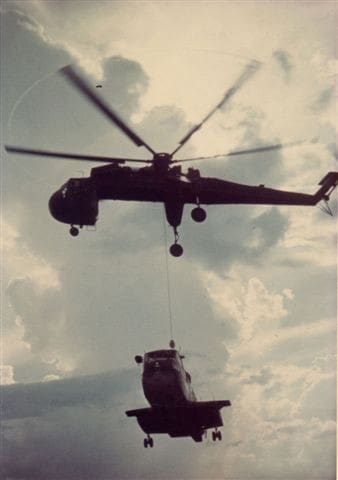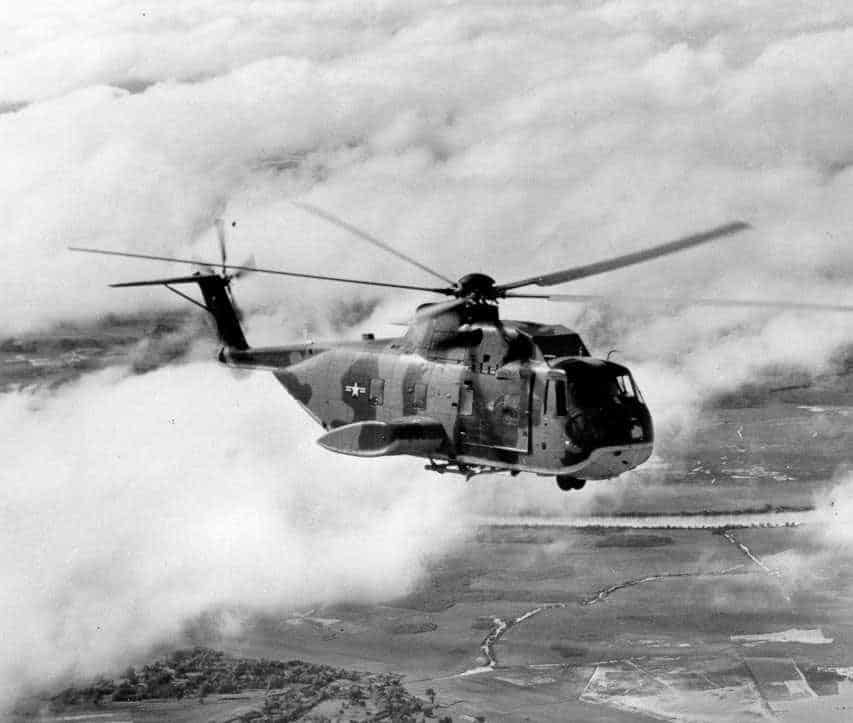
On 1 July Scotch 3, an F-105 Thunderchief was hit by anti –aircraft fire. Lt. Col. Jack Modica, the pilot, thought he could stay airborne long enough to reach the Gulf. This did not prove to be the case and he was forced to eject just north of Dong Hoi. A second pilot in the vicinity saw the chute and noted the approximate position as Modica disappeared into the North Vietnamese jungle. It was a low-level ejection and when he hit the ground he was knocked unconscious. It was two hours later that he filled the overhead FAC in on his condition. The time delay had given the North Vietnamese time to get to his location. To compound matters, he reported that something had happened to his back and he couldn’t move.
The first Jolly Green to go in was driven away several times and had to leave because of low fuel. LCDR Lonnie Mixon USCG was next to try. The A1 Sandys went in with suppression fire but Mixon soon learned it had little effect. The North Vietnamese hit the helicopter with ground fire and damaged a fuel tank, ruptured a hydraulic line, and knocked out part of the electrical system. He pulled off and the A1 strike aircraft went back in. Darkness was falling but the rescuers decided to try one more time. Mixon told the on scene commander that his helicopter was still flyable and that he would go in and make the attempt. He started in and tracers lit the night as the helicopter was hit again and again. Mixon had to break it off. Modica hid himself the best he could and spent the night on the ground.
The next morning the Jollys tried again but it didn’t go well. An A-1 was shot down, killing the pilot and a badly shot up HH-3E was returning to DaNang with a rocket lodged in the belly. It had penetrated a fuel cell but had failed to explode. Rescue forces were recalled. Several hours later, after a B-52 bomber strike close to the scene, a decision was made to make another attempt.
Jolly 21 was low bird and the crew, Lt. Lance Eagan, USCG, Aircraft Commander, with Maj. Bob Booth, USAF co-pilot, Sgt. Herb Honer, Engineer, and A1C Joel Talley PJ, knew that it was going to be a rough one. They would have to penetrate a well established “flak-trap” in order to make the pickup. Lance descended through very heavy 37mm anti-aircraft fire using twisting evasive maneuvers. He took several hits and the concussion from airbursts staggered the helicopter. Then he was through it and into the box canyon peering for Scotch 3 through the triple canopy. Eagan made radio contact and could see the smoke the downed airman was sending up, but due to the extremely dense jungle, it was impossible to sight the man. Modica was unable to help himself which made it necessary to send the PJ down on the penetrator. Eagan spotted a small opening in the jungle near Modica’s smoke, and Talley was lowered. Once on the ground, Talley looked up at the flight engineer who pointed in the direction of Modica. The undergrowth was so dense it took him a good bit of time to find the man. It was determined Modica’s pelvis was broken and that he must be moved as little as possible.
 Talley used his radio to vector the helicopter to his position. Eagan found himself in a small valley with tall trees and three sides rising 200 ft above him. There was no hostile fire directed at the Jolly 21 at this point in time but Eagan knew the North Vietnamese would zero in on the smoke. He had to get to Talley and Modica quickly and bring them up. With his height above the terrain limited by the length of the hoist cable, he edged ever closer to Talley’s position. The rotor blades lopped off the tops of some trees as he went until he could get no closer to the towering dominant tree that the injured pilot lay against. The penetrator was dropped and Talley carried the pilot the short distance to it. He had been on the ground for 18 minutes. He strapped himself and the pilot in then pushed his radio switch. Eagan heard Talley say “Take us up”.
Talley used his radio to vector the helicopter to his position. Eagan found himself in a small valley with tall trees and three sides rising 200 ft above him. There was no hostile fire directed at the Jolly 21 at this point in time but Eagan knew the North Vietnamese would zero in on the smoke. He had to get to Talley and Modica quickly and bring them up. With his height above the terrain limited by the length of the hoist cable, he edged ever closer to Talley’s position. The rotor blades lopped off the tops of some trees as he went until he could get no closer to the towering dominant tree that the injured pilot lay against. The penetrator was dropped and Talley carried the pilot the short distance to it. He had been on the ground for 18 minutes. He strapped himself and the pilot in then pushed his radio switch. Eagan heard Talley say “Take us up”.
The flight engineer started the hoist up and at that instant, Eagan caught sight of movement in front of him. The entire world seemed to erupt. The enemy, who had been waiting for the moment of vulnerability, sprang the trap. Intense automatic weapon fire came from below and in front of the helicopter. Hostile fire punctured the windshield spraying powdered glass all over him, but Eagan could not move until the PJ and rescued pilot cleared the tree tops. It seemed like an eternity then he heard a shout from the back that Modica and Talley were clear of the trees. Without hesitation, he pulled away, with the PJ and injured pilot swaying below the aircraft. He turned the aircraft to away from the ground fire. Once everyone was on board, he went directly to the field hospital at Dong Ha.
Eagan and his crew checked their Jolly. The titanium armor plating and luck saved them. The intensity of the fire showed in their battle damage. They had taken direct hits from large caliber automatic weapons. A total of 66 bullet holes were counted in the fuselage; the tail section had a gaping hole; four of the five rotor blades had been hit, and the self-sealing fuel tank had nine punctures in it. Eagan had missed being killed by a matter of inches and the copilot was saved by the titanium plating under his seat. The Jolly Green was deemed unflyable and was transported back to DaNang by a CH 54B Skycrane helicopter. The rescued pilot, Lt. Col. Jack Modica, was quoted as saying, “I’ve heard of the incredible jobs done by the rescue forces and now I’m convinced of it!”
Read More About The Jolly Greens:
1967 – Coast Guard – Air Force Pilot Exchange Program Initiated

